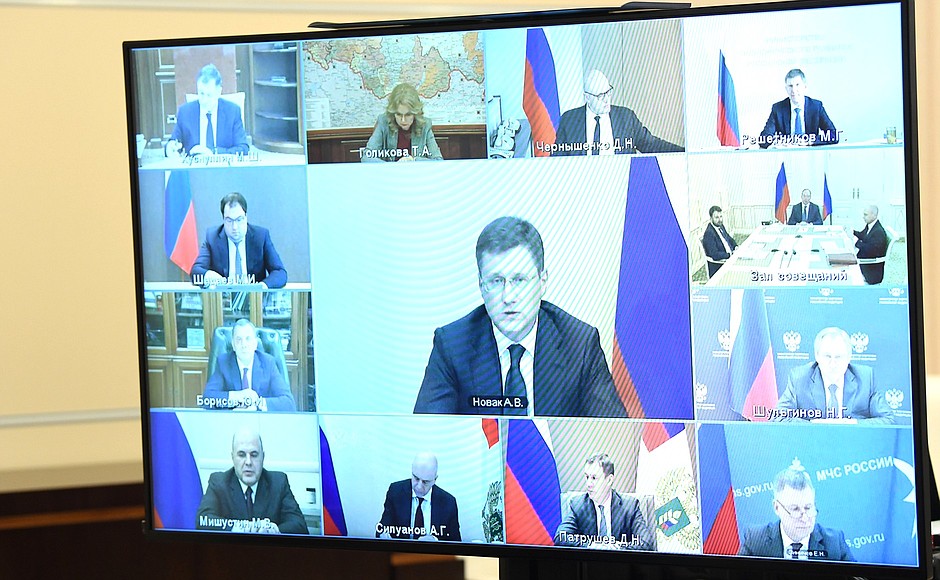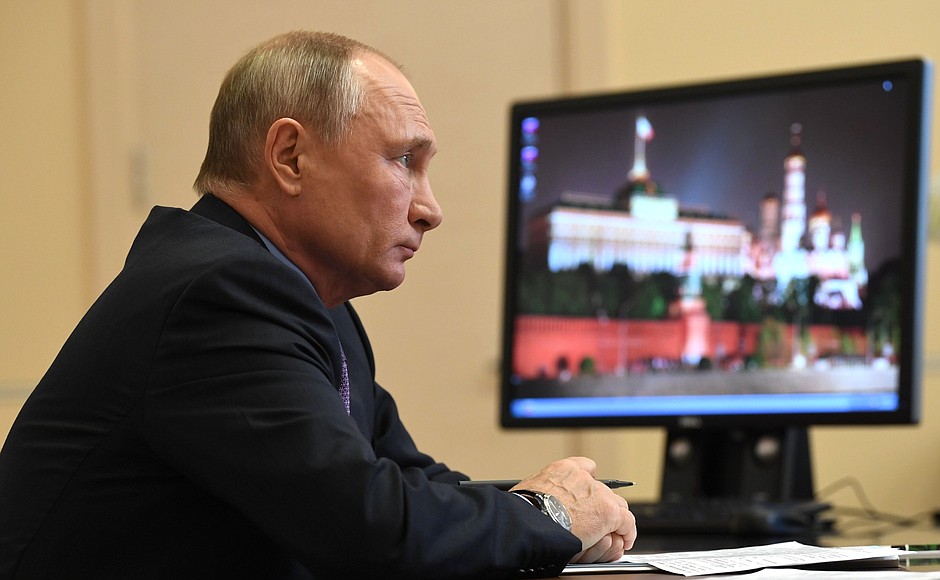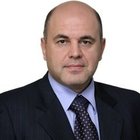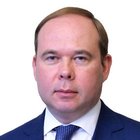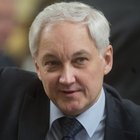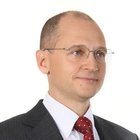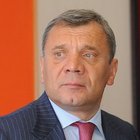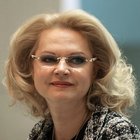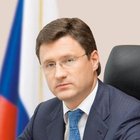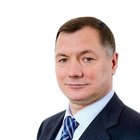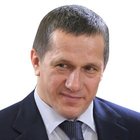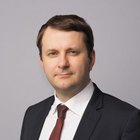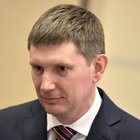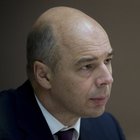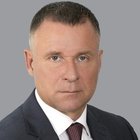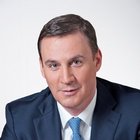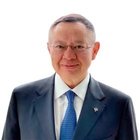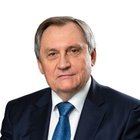The meeting was attended by Prime Minister Mikhail Mishustin, Chief of Staff of the Presidential Executive Office Anton Vaino, First Deputy Prime Minister Andrei Belousov, First Deputy Chief of Staff of the Presidential Executive Office Sergei Kiriyenko, Deputy Prime Ministers Yury Borisov, Tatyana Golikova, Dmitry Grigorenko, Alexander Novak, Marat Khusnullin, and Dmitry Chernyshenko, Deputy Prime Minister – Presidential Plenipotentiary Envoy to the Far Eastern Federal District Yury Trutnev, Presidential Aide Maxim Oreshkin, Minister of Economic Development Maxim Reshetnikov, Minister of Finance Anton Siluanov, Minister of Civil Defence, Emergencies and Disaster Relief Yevgeny Zinichev, Minister of Industry and Trade Denis Manturov, Minister of Agriculture Dmitry Patrushev, Minister of Construction, Housing and Utilities Irek Fayzullin, Minister of Digital Development, Communications and Mass Media Maksut Shadayev and Minister of Energy Nikolai Shulginov.
* * *
President of Russia Vladimir Putin: Colleagues, good afternoon.
Let us get started. Today we have a very important topic, something we always keep an eye on, as we should – the development of some of our high-tech areas. Let us talk about this in more detail; Andrei Belousov, Dmitry Chernyshenko and Denis Manturov will deliver keynote reports.
However, before we start discussing our main topic for today, I would like to ask Mr Alexander Novak to report to all our colleagues about how it went with our OPEC+ partners – given that this matter is of greatest importance to us. We do care about how the pricing situation in the world markets will develop, and much depends on this here in Russia. I would like to ask you, Mr Novak, to present things in such a way as to put our colleagues in the picture, give them an idea of the prospects of the industry for the near future, an industry that is most important to us.
Go ahead please, Mr Novak.
Deputy Prime Minister Alexander Novak: Thank you.
Good afternoon, Mr President.
Mr Prime Minister, colleagues,
I took part in the meeting of 22 countries last week, just as you instructed me. The main purpose of this meeting was to review performance under the OPEC+ agreements, as well as to assess the current situation on the market and discuss its prospects for next year. Of course, coordinating actions of OPEC countries after January 1, 2021, was the key item on the agenda.
Let me remind you that under the agreement that has been in force since April 10, 2020, the participating countries had to cut their overall production by a total of 7.7 million barrels per day. Under the same deal, the production adjustments were to be scaled down to 5.7 million barrels beginning on January 1, 2021, which would have meant a reduction in global output of 2 million barrels.
Considering the current market situation, participants expressed a wide range of views on what should happen after January 1, 2021, from increasing production by 2 million barrels per day to extending the current production cuts for a quarter or even six months.
It took a lot to come to an agreement. We even had to postpone the official meeting by two days due to the differences we had. In the end, we reached the following agreement. First, we reconfirmed the existing commitment under the agreement and the need to gradually return 2 million barrels to the market.
At the same time, recovery rates must be regulated by the state of the market.
Second, this agreement was subject to adjustment: starting in January, these countries will increase production by 500,000 barrels a day, thus decreasing the reduction volume from 7.7 million to 7.2 million barrels per day. Importantly, the increase in production distribution is supposed to be even, in accordance with output ratios.
And the third point: we agreed to hold monthly meetings starting in January to assess the market and decide on any further changes in production for the following month, given that each time this change cannot exceed 500,000 barrels.
We believe this decision fully meets Russia’s interests and allows us to increase production by another 125,000 barrels in January. Thus, considering we raised it by 500,000 barrels in August, the total production increase in Russia in January will be 625,000 barrels relative to the reductions that were introduced in May. Thus, we will restore production by 31 percent as compared to the highest reduction. In turn, this will stabilise our market.
That said, prices have been stabilized within a predictable range. Average oil prices have been $40-$45 a barrel during the term of this agreement. Let me recall that in April, the most difficult month, the average price of Brent was $26.6 a barrel. Now, in December, it has increased to $48-$49 per barrel. Monthly meetings help us make more precise and balanced decisions with consideration for market conditions, and gradually restore production while preventing both market excesses and overproduction.
As for the current market situation, I will say briefly that today we are seeing a partial recovery of the market and demand compared to April when demand for oil and petroleum products fell by about 22–25 million barrels per day. Although the drop in demand is lower than we predicted in summer, today it is only about 6–7 million barrels, In other words, the recovery has reached about 15–17 million barrels per day.
That said, we are seeing a reduction in the reserves of oil that was overproduced in the spring. Starting in July, the total reduction relative to average five-year figures amounted to about 100 million barrels per day. The key stock-exchange indexes are coming up. They have recovered by 10 to 30 percent.
Of the positive factors that influence the market, I would like to mention the end of US election activity and the announcement of three vaccines by the largest pharmaceutical companies, in addition to the Russian vaccines. And we are seeing that oil imports are also increasing in the Asia-Pacific Region by 2–2.5 percent even over last year.
A number of factors that negatively affect the market are still an influence. These include so-called uncertainties like the restrictions that some countries have introduced to counter the second wave of the pandemic. We are also seeing that, compared to the summer, there has been a huge reduction in commercial air flights, at about 60 percent of pre-crisis traffic levels. As for average vehicle use, this has gone down significantly compared to the summer when it was sharply recovering. Nevertheless, we are seeing that in spite of that, it is still much higher than during the crisis last spring.
We are observing the situation in the countries that are not members of the OPEC+ agreement, the United States, Canada, Norway and Brazil, to name a few. Considering market recovery and given price increases, these countries are gradually returning to investment and production activities, which must be monitored as well.
To sum up, Mr President, it is necessary to continue to watch and monitor the current market situation, and make the most rational and correct decisions for market stabilisation, primarily in the interests of Russia. We have agreed to hold the next meeting on January 4 to decide what actions to take in February.
Thank you. My report is over.
Vladimir Putin: Thank you very much.
Mr Siluanov, what is the Finance Ministry’s assessment of the agreements and what have we seen recently?
Minister of Finance Anton Siluanov: Mr President, colleagues,
In cooperation with Mr Novak, we have drafted proposals on Russia’s position. We believe that predictability in the oil market is one of the most important conditions both for financial stability and for the provision of resources for the budget and the National Wealth Fund.
We set the basic oil price at slightly over $43 per barrel for most of next year. Therefore, we believe the decisions Mr Novak just gave us will allow us to receive the planned budget revenues based on oil prices and maybe even replenish the National Wealth Fund that we use for financing structural projects.
Therefore, it seems to me that the predictability and stability of oil prices in the world market is the main achievement of our colleagues on oil price regulation.
Thank you.
Vladimir Putin: All right. Thank you very much.
I would like to ask you to say a few words about the preparedness of the power industry – the large energy sector, the grid complex – for winter. Winter has already arrived, we are seeing severe frosts in many regions of the Russian Federation. In this context, I would like to hear the opinion of Mr Shulginov. I am particularly interested in Trans-Baikal Territory, the Jewish Autonomous Area and Primorye Territory. At this point, I would like to ask Mr Faizullin to say a few words and then M Zinichev can join in.
(Later, the participants heard reports from Energy Minister Nikolai Shulginov, Minister of Construction, Housing and Utilities Irek Faizullin and Emergencies Minister Yevgeny Zinichev. In addition, at the President’s request, Minister of Agriculture Dmitry Patrushev reviewed the year in agriculture and the indicators for self-sufficiency in basic foods.)
Vladimir Putin: Let us move on to the main subject, the main report, the development of high-technology areas.
Mr Belousov, please. Mr. Chernyshenko and Mr Manturov, you will be next.
Go ahead, please.
First Deputy Prime Minister Andrei Belousov: Thank you very much.
Mr President, Mr Prime Minister, colleagues,
In the spring of this year, Mr President, you gave us instructions on developing certain high-tech areas that would be breakthrough, and systematic in nature. There are 11 key areas: artificial intelligence technology, four digital technologies, 5G mobile communication networks, the internet of things, the technology of distributed ledgers, and quantum technology. In studying the latter, the experts divided it into three different categories: quantum calculations, quantum communications and quantum sensorics.
Furthermore, these are technologies of new generation microelectronics and new materials and substances, the development of new and portable energy sources, technologies for transferring electricity and distributed smart energy systems, and future space systems and genetic technology.
It is necessary to choose a technological partner for each area, that is, a lead company that can ensure, in cooperation with the Government, the required organisational and financial support. Such companies must become the drivers of technological development during the entire life cycle: from research to scaling up and commercial use. Importantly, in the course of development, these companies must not monopolise these activities or harm competition or other companies.
The role of the lead companies is first and foremost to create centres of competencies that can study the monitoring of situations and education.
The second goal is to facilitate the development of the market and any required infrastructure.
The third goal is to attract extra-budgetary funding.
To organise this work, the lead companies must compile and endorse respective roadmaps in cooperation with the Government.
What are we ready to report? To date, we have selected our technological partners in nearly all spheres and signed partner agreements that clearly stipulate the sides’ obligations.
The Government’s partners include Sberbank, or Sber as it is called now, and the Russian Direct Investment Fund (RDIF) for Artificial Intelligence, Rostec for the Internet of Things, Blockchain Technology, Quantum Sensors and Microelectronics, as well as 5G Mobile Networks – together with Rostelecom.
Rosatom is responsible for quantum computing and the technology of new materials and substances, Rosseti for smart grid electricity transfer and distribution, RZD for quantum communications, Rostelecom for 5G networks, Rosneft for genetic technologies, and Roscosmos for prospective space systems.
We have approved and are implementing 10 roadmaps and other plans, and special competence centres have been established in nine spheres by companies that are our technological partners.
In all, 477 billion rubles of budget funds have been earmarked for the implementation of the approved roadmaps in 2020–2024, and the leading companies will provide a comparable sum, around 452 billion rubles, of own and borrowed funds. This adds up to nearly 1 trillion rubles, and this does not include private funds from other than the leading companies. We have special hopes for VEB’s competence in the field of syndicated loans for innovation and digitalisation projects.
Mr President, my colleagues who are responsible for these particular spheres can provide more detail.
If I may, I would like to speak some more about the development of artificial intelligence (AI) technologies, for which I am directly responsible together with Mr Chernyshenko.
As I have said, the Government’s partners in this sphere are Sber and RDIF. Allocations for 2021–2024 – without private funds – have been approved at 24.6 billion rubles of budgetary funds and some 62 billion rubles of the partners’ funds.
We are working in six practical spheres. I would like to speak about two of them.
The first area is support for small technological companies, the so-called start-ups. I would like to note that in the United States, China and other countries start-ups are playing the role of drivers in the development and application of AI technologies. The main task here is to create an effective mechanism of acceleration, from the selection and creation of teams and companies to the commercialisation and industrial implementation of their output, and to IPO.
The creation of this mechanism has been completed within the framework of the ongoing reform of our development institutions. It includes the National Technological Initiative (NTI) Platform, which is responsible for creating teams, and our development institutes, which are in charge of ensuring the so-called seamless integration of support measures: RDIF and the Russian Venture Company (RVC), the Fund for Assistance to Small Innovative Enterprises (FASIE) or the Bortnik Fund, Skolkovo, and the Fund for Infrastructure and Educational Programmes, with VEB’s organisational support.
In other words, a young team which has received start-up support from, say, the Bortnik Fund in the form of a seed grant for the implementation of its idea and has shown its worth will be able to use certain preferences such as RVC venture financing or subsidies for covering spending in the creation of an industrial prototype. In case of success, this company may hope to receive direct investment from RDIF or an easy-term loan at the mature stage for launching the batch manufacturing and marketing of its product. Approximately 10 large private Russian companies have been also involved in this project within the framework of the fund of funds, or a pool of funds, which is being established jointly with RSPP members.
A pilot project was launched in November to test this mechanism within the framework of NTI’s Archipelago 2035 for the acceleration of AI application. Some 16,000 people were involved.
The NTI Platform provided so-called pre-acceleration assistance to 800 teams. The Fund for Assistance to Small Innovative Enterprises assessed their performance and approved grants for 80 companies.
Overall, a relevant working group has been established. We plan to sign a joint memorandum this year and an agreement between these development institutions by February 1, 2021. Under this agreement, they will exchange information about start-ups and projects and, most importantly, they will have access to additional structured data about the success or failure of projects during the subsequent implementation phases. This will allow us to make decisions on support in an accelerated or priority manner. It will take some time, approximately two or three months, to adjust corporate procedures and fine-tune the project assessment and selection systems.
Overall, we intend to fast-track the selection of at least 100 artificial intelligence projects by the summer of next year. The corresponding framework has yet to be created, and we have been operating in manual mode thus far using the mechanisms provided by the National Technology Initiative (NTI). This has already yielded results. For example, DeepPavlov, a project based at the Moscow Institute of Physics and Technology, made it to the top 10 of the Amazon Alexa Prize, a prestigious competition in the field of conversational AI. In fact, this is the second year in a row that the project has made it to the top 10.
The project called Botkin.AI to create a universal platform for analysing and processing medical imagery and developed in cooperation with Rosatom has entered the industrial phase. So far, this has been the only AI solution in Russia to be registered with Roszdravnadzor [Federal Service for Supervision of Healthcare] as a Class IIb risk device. This technology helps medical professionals process medical imagery and diagnose various health conditions, including COVID-19. Moreover, it offers a number of unique applications that are unrivalled around the world.
Moving on, another NTI participant, GeoScan, has set a world record in the number of drones operated simultaneously by flying a swarm of 2,198 drones using AI. This is a breakthrough solution in terms of improving earth scanning accuracy by shooting from multiple angles and splitting the task among numerous UAVs for delivering on a wide range of tasks.
Let me note that global competition in this sector is quite intense. This record was set on September 3 in St Petersburg, and was timed to coincide with the 75th anniversary of Victory in the Great Patriotic War. The previous record dates back to 2018 and was set by Intel, a prominent global player. But today, GeoScan, a Russian company, has unseated Intel in this category.
The second track deals with regulations. In this regard, we have three priorities. The first is to ensure that people feel safe and comfortable when using AI technology. They have to understand that AI is there to help them, and is not a threat.
The second is that we need to enable the use of big data, including government data, while complying with all information security and data protection requirements for personal data and other sensitive information. AI cannot operate without big data, which can be described as AI’s “bread.” These are the key tracks and initiatives for this technology.
Thirdly, we need to create incentives for enabling AI use in various sectors of the economy and in social services.
Based on these priorities, the following fundamental laws have been passed this year: on the specifics of venture capital investment using government funds, the law on the right to risk, on experimental legal regulations in the field of digital innovation and on an artificial intelligence experiment in Moscow.
Mr President, in line with your instructions following the AI Journey international conference, the Government will ensure that two draft federal laws are submitted to the State Duma for review during the 2021spring session. Both bills are in the works now – one on experimental legal regulations in certain industries and the other on data circulation, including government data, in order to develop and implement artificial intelligence technologies.
Finally, in order to create a stimulating environment for the application of artificial intelligence in specific industries and areas, it is extremely important to update our technical regulations and standards.
The Ministry of Economic Development and Rosstandart [Federal Agency for Technical Regulation and Metrology] have developed a standardisation plan for 2021–2024, which includes about 200 standards. This plan will be approved by a Rosstandart order by the end of this year.
Now I would like to give the floor to Mr Chernyshenko, who will speak about other areas of work having to do with artificial intelligence.
This concludes my report. Thank you.
Vladimir Putin: These leading companies that we know about, the ones you just mentioned, how do you assess their work? We will talk more about this, but before we move on – do you think they show enough enthusiasm?
Andrei Belousov: I believe a number of companies are now producing excellent results.
I would certainly single out Sberbank here, which in fact now holds a leading position in AI-enabled areas.
Then there is Russian Railways, with its quantum communications. A special line, which is actually unique, was launched between Moscow and St Petersburg, one of the first lines in its kind. This is also a technological breakthrough of sorts.
Rostec is implementing many different projects, although with varying success.
And of course, I would like to highlight Rosatom, which has also created centres for artificial intelligence in various fields, such as new materials and medical technologies. They have also made a number of breakthroughs.
This is what I have now.
<…>
Ministry of Industry and Trade Denis Manturov: Mr President, Mr Prime Minister, colleagues,
The Ministry of Industry and Trade is charged with implementing three technological goals. As for the first of these – new generations of electronics and the development of the electronic component base (ECB) – the Government and Rostec Corporation have concluded an agreement that fully matches our updated Strategy for the Electronics Industry, and most importantly, the plan for its implementation. Given the sectoral similarities, we will work in the same bloc on quantum sensors. The Ministry of Digital Development is now transferring this work to our department.
Considering that the Government has decided to provide additional support for the radio-electronic industry, what I see as an enormous amount, 235 billion rubles until 2023, we will channel more than half of these funds into direct R&D, subsidies on creating a new microelectronics industry and the infrastructure for its development.
This year, the Government has funded in advance the development of laboratories on artificial intelligence and two co-working computer-aided design centres. In the future, this will allow our microelectronics designers to go over to domestic software as we discussed today.
Given the medium-term goals on digitising the economy, considerable funds have been allocated for developing chips for domestic databases in line with current topology standards, as well as artificial intelligence systems, including control of drones and security complexes, and for telecommunications equipment, such as 5G networks. Design bureaus established over the past few years with government support will be involved in this work. We will continue developing them. In addition, the Russian Foundation for Advanced Research Projects received the first tranches for over-the-horizon developments in electronics, including coherent elements and neuroprocessors, non-volatile storage and new radiolocation technology.
In line with your instructions, next year we plan to take a number of new measures to support producers. We will fund R&D in civilian microelectronics and provide subsidies for the development of the ECB and modules. In addition, we will support projects to develop equipment and materials and automated design systems that are used in the production and testing of microelectronics.
To encourage demand, next year we will increase the reimbursement of expenses for large-scale microelectronics producers. That said, a long-awaited ban on the purchase of imported microelectronics for government needs will come into force at that time. We hope that as a package these measures will allow our manufacturers to take over 40 percent of the domestic market by 2024, thereby more than doubling the profits on civilian products. In this way, we can enhance the reliability of control over communications systems, intelligent devices, smart sensors and critical infrastructure elements.
We are cooperating with Rosatom on developing new materials and substances. We have approved a roadmap for the further development of the production of composites, rare and rare-earth metals and additive technology. In addition to funding by the Ministry of Trade and Industry, the Ministry of Education and Science, and the Ministry of Economic Development, the main investment will come from private capital. In all, over 440 billion rubles will be invested in these areas. The main goal that you set for us on rare and rare-earth metals was to create a domestic raw-materials base. Two major projects are now being implemented for this purpose – the Tomtor deposit in the Republic of Sakha (Yakutia) and the Zashikhinskoye lithium and germanium deposit in Irkutsk.
The joint Stock Company Voskresensk Mineral Fertilizer (Uralchem) is another project on processing refuse dumps with the participation of the Moscow Region Government, Rosatom and Skygrad. It plans to produce rare-earth metals from phosphogypsum stack and gypsum products for further use in the construction industry. Overall, we plan to reduce our import dependence on rare metals to 50 percent and to 20 percent on rare-earth metals by 2024. This will make it possible to deliver Russian raw materials to petrochemical plants, oil refineries, auto catalyst makers, and synthetic rubber and wind energy producers.
As for composite materials, in the past five years we have supported 45 innovative projects worth over 6.5 billion rubles, thereby increasing production by 3.5 times. The products that are already manufactured under these projects are broadly used primarily in the civilian sector. These include composite railings, window structures, lighting poles, pipe culverts, bridgework and sports facilities. On the whole, by 2024 we plan to increase domestic production to 100 billion rubles and export a quarter of this amount.
To be continued.

